Odorants with multiple oxygen-containing functional groups and other odorants with high water solubility preferentially activate posterior olfactory bulb glomeruli
- PMID: 17366613
- PMCID: PMC2219924
- DOI: 10.1002/cne.21322
Odorants with multiple oxygen-containing functional groups and other odorants with high water solubility preferentially activate posterior olfactory bulb glomeruli
Abstract
In past studies in which we mapped 2-deoxyglucose uptake evoked by systematically different odorant chemicals across the entire rat olfactory bulb, glomerular responses could be related to each odorant's particular oxygen-containing functional group. In the present study we tested whether aliphatic odorants containing two such functional groups (esters, ketones, acids, alcohols, and ethers) would stimulate the combination of glomerular regions that are associated with each of the functional groups separately, or whether they would evoke unique responses in different regions of the bulb. We found that these very highly water-soluble molecules rarely evoked activity in the regions responding to the individual functional groups; instead, they activated posterior glomeruli located about halfway between the dorsal and ventral extremes in both the lateral and the medial aspects of the bulb. Additional highly water-soluble odorants, including very small molecules with single oxygenic groups, also strongly stimulated these posterior regions, resulting in a statistically significant correlation between posterior 2-deoxyglucose uptake and molecular properties associated with water solubility. By showing that highly water-soluble odorants stimulate a part of the bulb associated with peripheral and ventral regions of the epithelium, our results challenge a prevalent notion that such odorants would activate class I odorant receptors located in zone 1 of the olfactory epithelium, which projects to the dorsal aspect of the bulb.
(c) 2007 Wiley-Liss, Inc.
Figures
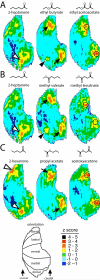
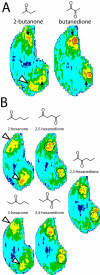
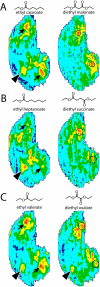
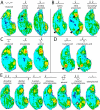
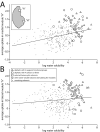


Similar articles
-
Effects of functional group position on spatial representations of aliphatic odorants in the rat olfactory bulb.J Comp Neurol. 2005 Mar 7;483(2):192-204. doi: 10.1002/cne.20415. J Comp Neurol. 2005. PMID: 15678475 Free PMC article.
-
Chemotopic representations of aromatic odorants in the rat olfactory bulb.J Comp Neurol. 2006 Jul 20;497(3):350-66. doi: 10.1002/cne.20982. J Comp Neurol. 2006. PMID: 16736464 Free PMC article.
-
Interactions between odorant functional group and hydrocarbon structure influence activity in glomerular response modules in the rat olfactory bulb.J Comp Neurol. 2005 Mar 7;483(2):205-16. doi: 10.1002/cne.20409. J Comp Neurol. 2005. PMID: 15678471 Free PMC article.
-
The olfactory bulb: coding and processing of odor molecule information.Science. 1999 Oct 22;286(5440):711-5. doi: 10.1126/science.286.5440.711. Science. 1999. PMID: 10531048 Review.
-
Grouping and representation of odorant receptors in domains of the olfactory bulb sensory map.Microsc Res Tech. 2002 Aug 1;58(3):168-75. doi: 10.1002/jemt.10146. Microsc Res Tech. 2002. PMID: 12203695 Review.
Cited by
-
The sedative effect of inhaled terpinolene in mice and its structure-activity relationships.J Nat Med. 2013 Oct;67(4):833-7. doi: 10.1007/s11418-012-0732-1. Epub 2013 Jan 22. J Nat Med. 2013. PMID: 23339024
-
Spatial representations of odorants in olfactory bulbs of rats and mice: similarities and differences in chemotopic organization.J Comp Neurol. 2009 Jun 20;514(6):658-73. doi: 10.1002/cne.22046. J Comp Neurol. 2009. PMID: 19363812 Free PMC article.
-
Photoperiod mediated changes in olfactory bulb neurogenesis and olfactory behavior in male white-footed mice (Peromyscus leucopus).PLoS One. 2012;7(8):e42743. doi: 10.1371/journal.pone.0042743. Epub 2012 Aug 9. PLoS One. 2012. PMID: 22912730 Free PMC article.
-
Cluster analysis of rat olfactory bulb responses to diverse odorants.Chem Senses. 2012 Sep;37(7):639-53. doi: 10.1093/chemse/bjs045. Epub 2012 Mar 29. Chem Senses. 2012. PMID: 22459165 Free PMC article.
-
Glomerular activity patterns evoked by natural odor objects in the rat olfactory bulb are related to patterns evoked by major odorant components.J Comp Neurol. 2010 May 1;518(9):1542-55. doi: 10.1002/cne.22289. J Comp Neurol. 2010. PMID: 20187145 Free PMC article.
References
-
- Araneda RC, Kini AD, Firestein S. The molecular receptive range of an odorant receptor. Nat Neurosci. 2000;3:1248–1255. - PubMed
-
- Astic L, Cattarelli M. Metabolic mapping of functional activity in the rat olfactory system after a bilateral transection of the lateral olfactory tract. Brain Res. 1982;245:17–25. - PubMed
-
- Astic L, Saucier D. Anatomical mapping of the neuroepithelial projection to the olfactory bulb in the rat. Brain Res Bull. 1986;16:445–454. - PubMed
-
- Buck L, Axel R. A novel multigene family may encode odorant receptors: A molecular basis for odor recognition. Cell. 1991;65:175–187. - PubMed
-
- Clancy AN, Schoenfeld TA, Forbes WB, Macrides F. The spatial organization of the peripheral olfactory system of the hamster. Part II: Receptor surfaces and odorant passageways within the nasal cavity. Brain Res Bull. 1994;34:211–241. - PubMed
Publication types
MeSH terms
Substances
Grants and funding
LinkOut - more resources
Full Text Sources
Miscellaneous

